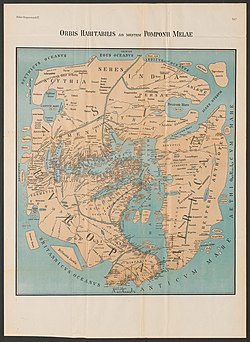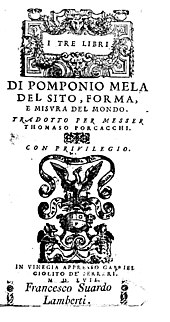Pomponius Mela

Pomponius Mela, who wrote around AD 43, was the earliest known
His short work (De situ orbis libri III.) remained in use nearly to the year 1500.[1] It occupies less than one hundred pages of ordinary print, and is described by the Encyclopædia Britannica (1911) as "dry in style and deficient in method, but of pure Latinity, and occasionally relieved by pleasing word-pictures."[2] Except for the geographical parts of Pliny's Historia naturalis (where Mela is cited as an important authority), the De situ orbis is the only formal treatise on the subject in Classical Latin.
Biography

Little is known of Pomponius except his name and birthplace—the small town of Tingentera or Cingentera (identified as Iulia Traducta) in southern Spain, on Algeciras Bay (Mela ii. 6, § 96; but the text is here corrupt).[3] The date of his writing may be approximately fixed by his allusion (iii. 6 § 49) to a proposed British expedition of the reigning emperor, almost certainly that of Claudius in AD 43. That this passage cannot refer to Julius Caesar is evidenced by several references to events of Augustus's reign; especially to certain new names given to Spanish towns. Mela, like the two Senecas, Lucan, Martial, Quintilian, Trajan, Hadrian, were all part of Italic communities settled in various parts of Spain that eventually relocated in Rome.[4] It has been conjectured that Pomponius Mela may have been related in some way to Marcus Annaeus Mela, son of Seneca the Elder and father of Lucan.[5][6][7]
Geographical knowledge
The general views of the De situ orbis mainly agree with those current among Greek writers from Eratosthenes to Strabo; the latter was probably unknown to Mela. But Pomponius is unique among ancient geographers in that, after dividing the Earth into five zones, of which two only were habitable, he asserts the existence of antichthones, inhabiting the southern temperate zone inaccessible to the folk of the northern temperate regions from the unbearable heat of the intervening torrid belt. On the divisions and boundaries of Europe, Asia and Africa, he repeats Eratosthenes; like all classical geographers from Alexander the Great (except Ptolemy) he regards the Caspian Sea as an inlet of the Northern Ocean, corresponding to the Persian and Arabian (Red Sea) gulfs on the south.

His
Descriptive method
Mela's descriptive method follows ocean coasts, in the manner of a
Editions

The editio princeps of Mela was published at Milan in 1471; the first critical edition was by Joachim Vadian (Wien, 1518), superseded by those of Johann Heinrich Voss (1658), Johann Friedrich Gronovius (1685 and 1696), A. Gronovius (1722 and 1728), and Tzschucke (1806–1807), in seven parts (Leipzig; the most elaborate of all); G. Paithey's (Berlin, 1867) for its text. The English translation by Arthur Golding (1585) was celebrated.[8]
A recent English translation is that of F. E. Romer, originally published in 1998.

- I tre libri di Pomponio Mela del sito, forma, e misura del mondo (in Italian). Venezia: Gabriele Giolito de Ferrari. 1557.
References
- ISBN 9780674822702. Retrieved 6 May 2018.
- Bunbury, Edward Herbert; Beazley, Charles Raymond (1911). "Mela, Pomponius". Encyclopædia Britannica. Vol. 18 (11th ed.). p. 87.
- ^ Tegg, Thomas (1824). Chronology, or The historian's companion (3rd ed.). London: Thomas Tegg. p. 284.
- ISBN 9780472107735.
- ^ Walter C. A. Ker (1919). Martial's Epigrams. London: William Heinemann.
[By 'Seneca's house illustrious for its triple names'] M. means Seneca, the philosopher and tutor of Nero, his brother Gallio, and Annaeus Pomponius Mela, the writer on geography.
J. Wight Duff characterizes this as "a serious confusion between Annaeus Mela, who was Seneca's brother, and Pomponius Mela, the geographer." - The Classical Review. 34 (7–8). London: John Murray: 177.
- ^ Romer 1998, "Introduction", p. 4.
- ^ See also Edward Bunbury, Ancient Geography, ii. 352–368, and D. Detlefsen, Quellen und Forschungen zur alten Gesch. und Geog. (1908).
Sources
- Romer, Frank E. (1998). Pomponius Mela's Description of the World. Ann Arbor: University of Michigan Press. ISBN 9780472084524.
- Editions in the original Latin in the Internet Archive
- Books I, II and III in Latin, digitised at The Latin Library
- Attribution
This article incorporates text from a publication now in the
